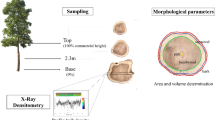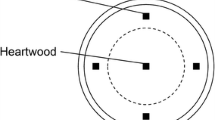Abstract
We measured the concentrations of extractable bioactive compounds in heartwood of live yellow-cedar (Chamaecyparis nootkatensis) trees and five classes of standing snags (1–5, averaging 4, 14, 26, 51, and 81 years-since-death, respectively) to determine how the concentrations changed in the slowly deteriorating snags. Three individuals from each of these six condition classes were sampled at four sites spanning a 260-km distance across southeast Alaska, and the influence of geographic location on heartwood chemistry was evaluated. Cores of heartwood were collected at breast height and cut into consecutive 5-cm segments starting at the pith. Each segment was extracted with ethyl acetate and analyzed by gas chromatography. Concentrations of carvacrol, nootkatene, nootkatol, nootkatone, nootkatin, and total extractives (a sum of 16 compounds) for the inner (0–5 cm from pith), middle (5–10 cm from pith), and surface (outer 1.1–6.0 cm of heartwood) segments from each core were compared within each tree condition class and within segments across condition classes. Heartwood of class 1 and 2 snags had the same chemical composition as live trees. The first concentration changes begin to appear in class 3 snags, which coincides with greater heartwood exposure to the external environment as decaying sapwood sloughs away, after losing the protective outer bark. Within core segments, the concentrations of all compounds, except nootkatene, decrease between snag classes 2 and 5, resulting in the heartwood of class 5 snags having the lowest quantities of bioactive compounds, although not different from the amounts in class 4 snags. This decline in chemical defense is consistent with heartwood of class 5 snags being less decay-resistant than heartwood of live trees, as observed by others. The unique heartwood chemistry of yellow cedar and the slow way it is altered after death allow dead trees to remain standing for up to a century with a profound impact on the ecology of forests in southeast Alaska where these trees are in decline.




Similar content being viewed by others
References
Y.-J. Ahn S.-B. Lee H.-S. Lee G.-H. Kim (1998) ArticleTitleInsecticidal and acaricidal activity of carvacrol and β-thujaplicine derived from Thujopsis dolabrata var. hondai sawdust J. Chem. Ecol. 24 81–90 Occurrence Handle10.1023/A:1022388829078
G. M. Barton (1976) ArticleTitleA review of yellow cedar (Chamaecyparis nootkatensis [D. Don] Spach) extractives and their importance to utilization Wood Fiber 8 172–176
S. Burt (2004) ArticleTitleEssential oils: their antibacterial properties and potential applications in foods—A review Int. J. Food Microbiol. 94 223–253 Occurrence Handle10.1016/j.ijfoodmicro.2004.03.022 Occurrence Handle15246235
R. C. DeGroot B. Woodward P. E. Hennon (2000) ArticleTitleNatural decay resistance of heartwood from dead, standing yellow-cedar trees: laboratory evaluations For. Prod. J. 50 53–59
M. Friedman P. R. Henika R. E. Mandrell (2002) ArticleTitleBactericidal activities of plant essential oils and some of their isolated constituents against Campylobacter jejuni, Escherichia coli, Listeria monocytogenes, and Salmonella enterica J. Food Prot. 65 1545–1560 Occurrence Handle12380738
D. W. Green K. A. McDonald P. E. Hennon J. W. Evans J. H. Stevens (2002) ArticleTitleFlexural properties of salvaged dead yellow-cedar from southeast Alaska For. Prod. J. 52 81–88
Harris, A. S., Hutchison, O. K., Meehan, W. R., Swanston, S. N., Helmers, A. E., Hendee, J. C., and Collins, T. M. 1974. The forest ecosystem of Southeast Alaska. 1. The setting. USDA Forest Service. General Technical Report PNW-12.
P. E. Hennon (1990) ArticleTitleFungi on Chamaecyparis nootkatensis Mycologia 82 59–66
P. E. Hennon C. G. Shaw SuffixIII (1994) ArticleTitleDid climatic warming trigger the onset and development of yellow-cedar decline in Southeast Alaska? Eur. J. For. Pathol. 24 399–418
P. E. Hennon C. G. Shaw SuffixIII (1997) ArticleTitleThe enigma of yellow-cedar decline: what is killing these long-lived, defensive trees? J. For. 95 4–10
P. E. Hennon C. G. Shaw SuffixIII E. M. Hansen (1990) ArticleTitleDating decline and mortality of Chamaecyparis nootkatensis in Southeast Alaska For. Sci. 36 502–515
P. E. Hennon E. M. Hansen C. G. Shaw SuffixIII (1990b) ArticleTitleCauses of basal scars on Chamaecyparis nootkatensis in Southeast Alaska Northwest Sci. 64 45–54
P. E. Hennon E. M. Hansen C. G. Shaw SuffixIII (1990c) ArticleTitleDynamics of decline and mortality of Chamaecyparis nootkatensis in Southeast Alaska Can. J. Bot. 68 651–662
P. E. Hennon C. G. Shaw SuffixIII E. M. Hansen (1990d) ArticleTitleSymptoms and fungal associations of declining Chamaecyparis nootkatensis in Southeast Alaska Plant Dis. 74 267–273
P. E. Hennon D. T. Wittwer J. Stevens K. Kilborn (2000) ArticleTitlePattern of deterioration and recovery of wood from dead yellow-cedar in Southeast Alaska West. J. Appl. For. 15 49–58
Hennon, P. E., McClellan, M. H., and Palkovic, P. 2002. Comparing deterioration and ecosystem function of decay-resistant and decay-susceptible species of dead trees. USDA Forest Service General Technical Report PSW-GTR-181.
B. M. Kard E. J. Mallette (1997) ArticleTitleResistance of six wood products used in paneling to Reticulitermes jlavipes (Isoptera: Rhinotermitidae) J. Econ. Entomol. 90 178–182
Khasawneh, M. A. 2003. Natural and semi-synthetic compounds with biocidal activity against arthropods of public health importance. Ph.D. dissertation. Oregon State University, Corvallis.
J. Knowles S. Roller (2001) ArticleTitleEfficacy of chitosan, carvacrol, and a hydrogen peroxide-based biocide against foodborne microorganisms in suspension and adhered to stainless steel J. Food Prot. 64 1542–1548 Occurrence Handle11601703
L. Maistrello G. Henderson R. A. Laine (2001) ArticleTitleEfficacy of vetiver oil and nootkatone as soil barriers against Formosan subterranean termite (Isoptera: Rhinotermitidae) J. Econ. Entomol. 94 1532–1537 Occurrence Handle11777060
McDonald, K. A., Hennon, P. E., Stevens, J. H., and Green, D. W. 1997. Mechanical properties of salvaged dead yellow-cedar in southeast Alaska. USDA Forest Service. Research Paper FPL-RP-565.
Y. Oka S. Nacar E. Putievsky U. Ravid Z. Yaniv Y. Spiegel (2000) ArticleTitleNematicidal activity of essential oils and their components against the root-knot nematode Phytopathology 90 710–715
N. A. Panella J. Karchesy G. O. Maupin J. C. S. Malan J. Piesman (1997) ArticleTitleSusceptibility of immature Ixodes scapularis (Acari: Ixodidae) to plant-derived acaricides J. Med. Entomol. 34 340–345 Occurrence Handle9151500
E. Rennerfelt G. Nacht (1955) ArticleTitleThe fungicidal activity of some constituents from heartwood of conifers Sven. Bot. Tidskr. 49 419–432
D. E. Rhoades (1990) ArticleTitleAnalysis of monoterpenes emitted and absorbed by undamaged boles of lodgepole pine Phytochemistry 29 1463–1465 Occurrence Handle10.1016/0031-9422(90)80101-L
SAS Institute Inc. 1999. SAS OnlineDoc®, Version 8. SAS Institute Inc., Cary, NC.
G. W. Schade A. H. Goldstein M. S. Lamanna (1999) ArticleTitleAre monoterpene emissions influenced by humidity? Geophys. Res. Lett. 26 2187–2190 Occurrence Handle10.1029/1999GL900444
R. S. Smith (1970) ArticleTitleBlack stain in yellow cedar heartwood Can. J. Bot. 48 1731–1739
R. S. Smith A. J. Cserjesi (1970) ArticleTitleDegradation of nootkatin by fungi causing black heartwood stain in yellow cedar Can. J. Bot. 48 1727–1729
R. G. D. Steele J. H. Torrie D. A. Dickie (1997) Principles and Procedures of Statistics: ABiometrical Approach EditionNumber3 McGraw-Hill Boston
D. P. Thompson (1996) ArticleTitleInhibition of growth of mycotoxigenic Fusarium species by butylated hydroxyanisole and/or carvacrol J. Food Prot. 59 412–415
A. Ultee E. P. W. Kets E. J. Smid (1999) ArticleTitleMechanisms of action of carvacrol on the food-borne pathogen Bacillus cereus Appl. Environ. Microbiol. 65 4606–4610 Occurrence Handle10508096
K. Voda G. Boh M. Vrtačnik F. Pohleven (2003) ArticleTitleEffect of the antifungal activity of oxygenated aromatic essential oil compounds on the white-rot Trametes versicolor and the brown-rot Coniophora puteana Int. Biodeterior. Biodegrad. 51 51–59 Occurrence Handle10.1016/S0964-8305(02)00075-6
Xioung, Y. 2000. Essential oil components of Alaska cedar heartwood. MS thesis, Oregon State University, Corvallis.
B. C. R. Zhu G. Henderson F. Chen L. Maistrello R. A. Laine (2001) ArticleTitleNootkatone is a repellent for Formosan subterranean termite (Coptotermes formosanus) J. Chem. Ecol. 27 523–531 Occurrence Handle10.1023/A:1010301308649 Occurrence Handle11441443
Author information
Authors and Affiliations
Corresponding author
Rights and permissions
About this article
Cite this article
Kelsey, R.G., Hennon, P.E., Huso, M. et al. Changes in Heartwood Chemistry of Dead Yellow-Cedar Trees that Remain Standing for 80 Years or More in Southeast Alaska. J Chem Ecol 31, 2653–2670 (2005). https://doi.org/10.1007/s10886-005-7618-6
Received:
Accepted:
Published:
Issue Date:
DOI: https://doi.org/10.1007/s10886-005-7618-6




